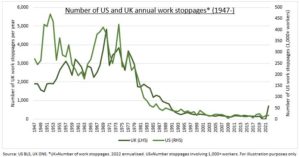DISCONTENT: The UK faces a ‘winter of discontent’. Real wages are declining at the largest pace ever and forecasts are for the biggest fall in living standards since records began. This is driving a spike in strike action and labour disruption. Postal, rail, telecom, and university workers have struck, and health workers are threatening. This UK is leading but the trend is global. US strike action is rising. The latest threat from rail workers, controlling 40% of freight capacity. French air, energy, utility workers lead a pick up in action across Europe. Wage pressures are a reality for businesses today but disruption is a fraction of the 1970’s (see chart). Labour markets have changed, price expectations are well anchored, and rising unemployment is still to come.
CHANGE: This restrained labour disruption highlights big changes to labour markets in recent decades. Manufacturing has plunged to 9% and 11% of GDP in the UK and US, half levels three decades ago. Flexible work arrangements have risen sharply. 25% of UK and 16% US workers now work part time. Female labour force participation has also surged. Unionisation has fallen to only 10% of workforce in US and 23% in UK. And this is now dominated four-to-one by public sector. Whilst legislation around unionisation and strike action have tightened in many countries.
IMPACT: Wage pressures are a business reality today, with inflation high and unemployment still low. This is a particular pressure for those sectors with big labour needs, from banking to healthcare. This will cyclically ease as unemployment rises and with inflation expectations well-anchored – unlike the lost decade of the 1970’s. Whilst structurally this is a tailwind for automation and robotics and new work arrangements. See @GigEconomy and @RemoteWork.

All data, figures & charts are valid as of 22/11/2022






